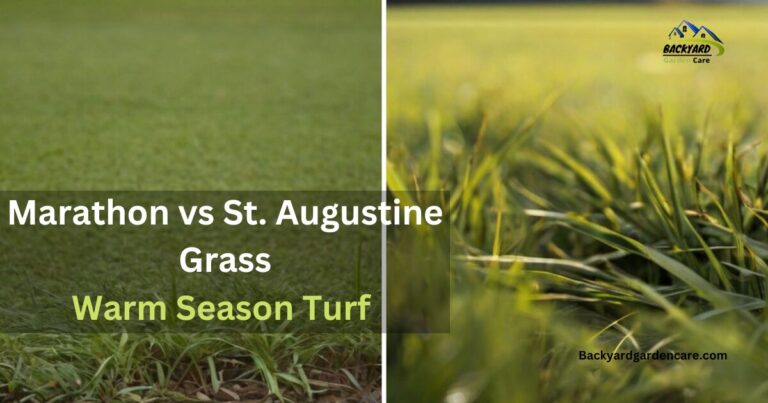Mow Before Or After Weed And Feed: 3 Best Ideal Timelines for Weed and Feed Applications
Early spring marks that coveted time of lush green bringing the lawn and garden back to life. Emerging blooms blanket the beds as vibrant grass chases off winter’s dreary dormancy once again. But just as your landscape awakens, so too springs a slew of challenges threatening the idyllic curb appeal vision after months of waiting indoors. Dandelions scatter their yellow bane with no regard for boundaries. Thick crabgrass blades taunt orderly lawn uniformity and daring intervention.
Homeowners nationwide anguish trying to parse the ideal timeline balancing early spring fertilization against pre-emergent weed control. Does weed and feed application work most effectively before or after the mowing season commences? What factors determine best practices on these fronts? Proper timing and coordination become crucial when attempting to nourish desired growth while eliminating unwanted infestations.
In this comprehensive guide, readers will uncover expert-backed recommendations on seamlessly integrating fertilizer and weed-killing schedules for picture-perfect turf. Specifically, you will discover:
- Granular overview detailing different weed and feed product categories and how each works against invaders through combined action
- In-depth analysis weighing the potential benefits behind mowing first before deploying treatment
- Examination of valid cases favoring weed and feed application prior to running mowers
- Veteran landscaper insights on real-world conditioning supporting each approach
- Customizable timelines and benchmarks for optimizing efficacy of coordinated yard maintenance
- Answers to frequently asked application order and timing questions
Implement the evidence-based best practices advised here helping coordinate lush green grass with vanishing weeds! Let’s get into the specifics of Mow Before Or After Weed And Feed solutions before outlining optimal spring care timelines.
Understanding Weed and Feed Products

Weed and feed represent one of the most popular combined chemical care solutions leveraged by homeowners striving for lush, weed-free lawns with limited time. But how does it actually work? And why might coordinating its application with regular mowing necessitate careful consideration? Let’s unpack the mechanics and methodology behind modern weed and feed.
How Weed and Feed Works
These consolidated treatments harness dual-action efficacy convenience through layering targeted pre- and post-emergent herbicides like Wondercide and Cedarcide alongside balanced slow-release nitrogen and potassium for fertilization. Applied simultaneously, the combined granules curtail sprouting weeds while nourishing the desired turf for approximately 6-8 weeks through a single spreading.
Weed-preventative components coat most weed and feed products using herbicides that disrupt cell growth as seeds initially germinate. This prevents future turf invasion without killing mature, established weeds. Combining this pre-emergent barrier with selective post-emergent foliar weed killers or weed controllers provides more extensive infestation control.
Different Weed and Feed Types and Key Ingredients
Weed and feed formulations range from strictly chemical iterations to combinations with corn gluten meal for pre-emergent organic weed prevention. Some leverage penalizing synthetic auxins similar to 2,4-D that specifically target broadleaves. Others utilize Phoma macro stoma fungus biocontrol’s harmless to grass species applied through granules. When purchasing, scrutinize labels for your weeds list and lawn grass type.
Application Schedule Planning
Unlike routine fertilizer, weed and feed treatments require more purposeful scheduling optimization around not just feeding grass but curtailing weeds and Destroy Annoying Briars. Factor your region’s average spring soil temperature rise meeting labeled germination prerequisites. Most products necessitate repeat spreading approximately 45 days later for comprehensive control through changing growth waves. Accommodate watering absorption and foot traffic delays as well between application and mowing or vice versa. Careful coordination ensures success!
Now that we have covered the basics on weed and feed approaches and planning, let’s weigh arguments supporting application both before and after mowing spring turf. What priorities might help determine the ideal temperature, order and timing for Lawn mowing?
The Case for Mow Before Or After Weed And Feed First

When planning coordinated spring lawn care, the case for mowing turf first before deploying weed and feed holds several compelling benefits:
Enables Removal of Messy Debris Improving Treatment Contact
Mowing initially takes care of clearing longer matted grass and fallen leaves/branches that accumulate through winter dormancy before active growth resumes. Such debris shields soil obstructing complete herbicide contact. Removing buildup through a quick mowing pass enables treatment granules to reach turf crowns and surrounding bare earth more easily. Any remnants also decompose faster preventing messy clumping rotting under layers of uncut grass.
Allows Soil-Level Products to Reach Target Surface
Pre-emergent weed barriers rely on coating topsoil preventing sprouted seeds from anchoring roots. But shaggy unmowed turf creates insulation barriers preventing soil contact. Similarly, post-emergent options need foliage contact. Mowing first ensures shorter grass blades no longer impede granules falling to where treatment takes effect. The visual indicator of the applied product against soil also confirms coverage uniformity.
Avoids Delaying Maintenance Waiting for Ideal Dryness
Especially in early spring when soil moisture runs high, mowing wet grass risks rutting damage and poor cut quality. But daily growth surges necessitate frequent cutting to maintain a neat appearance. By mowing first when conditions allow proper timing, you avoid postponing mowing repeatedly while waiting through days of heavy rainfall or morning dew awaiting dryness suitable for weed and feed application. This prevents grass from getting severely overgrown.
While strong arguments favor mowing first, also recognize a few precautions if taking this approach:
- Mow 2-3 days before weed and feed treatment allowing grass to dry and recover from cutting stress.
- Remove no more than 30% grass blade mass when mowing to avoid stunting growth.
- Observe ideal regional soil temperature requirements before applying weed preventatives.
- Water grass the morning of treatment to enable soil absorption.
- Wait for the label-designated period before mowing again after application.
What factors might still favor applying weed and feed first depending on home lawn traits or climate? Evaluate benefits unique to your landscape.
The Argument for Mowing After

When it comes to applying weed and feed treatments to your lawn, many homeowners wonder if it’s better to mow first or apply the product first. There are good arguments on both sides but allowing your grass blades to grow out a bit before an application can have unique benefits for absorption and visibility. Let’s dive deeper on why you may want to mow after weed and feeding your lawn.
Granule Retention
Weed and feed are thoroughly dissolved and absorbed when stuck to leaf tissue 3-5 days before mowing. This reduces wasted product versus mowing first. Always check drying times before disturbing treatment. Allowing binding prevents displacement from grass clippings.
Leaf Tissue Absorption
Taller blades enable increased foliar intake of active ingredients before cutting. Chemicals permeate leaves, translocating down through plant tissues before mowing for enhanced weed control and nutrient efficacy versus root uptake alone.
Visible Indicator
Mowing after treatment indicates application coverage. Height shows where granules were applied versus missed patches that need spot treatment before the next uniform cut. Colored granules make this more pronounced.
Optimal Timeline
Wait 72 hours between application and mowing. This enables drying and adherence to plant tissue for intake through leaves and roots. Allow 24 hours before watering so rain doesn’t displace the product before fully binding.
Weather delays may require adjusting plans. Forecast precipitation means postponing treatment a few days until dry conditions resume. Routine mowing can continue per schedule after the initial 3-day rest period. Expect gradual weed removal and grass filling in over 2-4 weeks.
With some strategic timing considerations, applying weed and feed both before AND after mowing your lawn can be an effective 1-2 punch. Just be sure to coordinate proper spacing based on label guidance and weather forecasts. A few simple planning steps will ensure ideal absorption both through the leaves and down into the soil and roots for maximized treatment performance. Here’s to winning the battle against weeds in your turf grass!
Expert Insights on Application Best Practices
Industry experts weigh in on key qualifiers supporting both pre-and post-treatment mowing approaches when applying weed and feed. They also provide guidance on ideal coordination with fertilizer use and irrigation scheduling.
Mow First Qualifiers
Mowing overgrown lawns first enables uniform product distribution on shorter blades. It also removes debris barriers compromising adherence. Another scenario favoring upfront mowing is with spray-on formulations. Liquids often perform best on freshly cut leaf tissue versus relying on granule visibility on taller grass to indicate coverage.
Mow After Qualifiers
If the grass is already an even, maintained height, delaying mowing 3-5 days enables binding and absorption opportunities before cutting whisks some granules away. Visible indicators on taller blades also show application uniformity. Newer leaf-tissue-focused products work optimally on longer grass allowing ingredient transit down to the roots before mowing.
Fertilizer Guidance
Apply fertilizer based on soil tests like pH level and acidity, not just a calendar schedule. This avoids over-feeding and added grass stress. Consider alternating dedicated fertilizer and weed control treatments instead of combined products unless facing severe weed infestation. More gentle, consistent care proves superior to intense “shock” attempts.
Watering Tips
Water thoroughly 1-2 days before applying treatment, then avoid irrigation for 24-48 hours afterwards. This bracketed dry window prevents washing away granules before binding or removing spray contact from leaf tissue. Time your application forecasts accordingly.
The key takeaway is knowing specific conditions and adhering to product instructions while tracking results over time. Refine your lawn care regimen based on how your turf grass responds each season. Here’s to customizing an ideal partnership.
Ideal Timelines and Results Expectations
Getting the timing right in coordinating mowing, weed and feed application, irrigation and other lawn care steps leads to success. While allowing flexibility to adjust for weather delays, adhering to general time minimums and maximums will prove most efficacious. Here are expert guidelines on ideal timelines and what results to realistically expect.
Number of Days Between Application & Mowing
Whether you mow before or after applying weed and feed treatment, allow 2-3 days of dry conditions before the other step. This enables adequate foliar uptake and soil activation of products before mowing might whisk some granules away or disrupt leaf absorption. If mowing first, the same dry period allows herbicide and fertilizer ingredients to adhere to freshly cut grass.
When mowing after treatment, wait at least 72 hours before cutting grass again. This allows granules to bind firmly to leaf tissue and visible indicators to emerge showing coverage uniformity. It also enables some upward translocation into plants before mowing severs some blades.
Adjusting for Weather Delays
Local weather inevitably impacts lawn care schedules. If rainfall occurs within 48 hours before or after applying weed and feed, efficacy will be reduced. Granules will disintegrate and wash away before absorbing or adhering properly. Liquid formulations also require a dry yard and leaves for optimal contact.
Check forecasts religiously and be prepared to adjust plans. If showers are coming, postpone treatment a few days until at least 72 hours of dry conditions return. Avoid laying product down right before storms or during rainy stretches lasting over a week. Be patient for the ideal dry application window based on seasonal norms in your area.
Realistic Results Expectations
When timed properly around weather, outstanding weed and feed treatment results are achievable but rarely overnight miracles. Typically expect to wait at least 2-3 weeks before noticeable changes emerge. Early signs include yellowing or wilting weeds as the non-selective herbicides take effect. Grass color and density may then improve as fertilizer ingredients activate growth.
Full weed decomposition and removal takes 4-6 weeks depending on specific products and application rates. Repeat spot spraying is sometimes necessary. Thin fescue may fill in over 2-3 months. Transition timing expectations by warning it’s not a one-and-done fix but rather the commencement of an ongoing weed management partnership.
Proper timing between mowing, irrigation, rest periods and treatment truly impacts efficacy over this first critical month. Adhering to label guidance and expert best practices will give products their best chance to work. Closely monitor changes in weed levels and grass lustre while maintaining consistent mowing height. Keep photographic records and an application journal to track results year-over-year while refining your custom lawn care regimen for lasting success. Then refer friends to your services as the neighborhood weed-free lawn guru!
Ideal Timelines from a Veteran Gardener

Joe Green maintains the popular YouTube channel “Greener Grass” documenting his 50+ years of landscaping experience. With over 100k subscribers, amateur gardeners rely on Joe’s practical wisdom. His Maryland zone 7a tall fescue lawn exemplifies a model for success through strategic weed and feed application timing.
Joe warns that whether mowing before or after treatment, allowing 2-3 dry days enables adequate foliar and soil activation before disruption. When weather delays strike, postpone plans until at least 3 dry days return. Joe admits even experts must adapt to reality while protecting product efficacy.
On managing expectations, Joe notes outstanding but realistic results take 2-4 weeks as ingredients fully transpire through leaf tissue down Pachysandra Ubiquitous roots to choke weeds out. Repeat spot spraying, consistent mowing height and monitoring progress are key in this initial month. Rather than a one-time fix, Joe emphasizes properly timed weed and feed applications to commence an ongoing partnership.
Veteran gardeners like Joe with real-world expertise provide guidance lawn care enthusiasts can rely on. Blending science-based product directions with practical wisdom enables both success and forgiveness when weather interferes. Patience and persistence pay off over time!
Conclusion
When coordinating weed and feed applications with the regular mowing and watering of your lawn, proper timing truly impacts results. While there are viable cases supporting both pre-and post-treatment mowing, a few key takeaways rise to the top:
- Allow 2-3 days of dry weather before and after any weed and feed application, regardless of mowing order. This enables granules to fully adhere and liquid sprays to penetrate leaf tissue without weather interference before cutting or watering activities resume.
- Let product visibility on taller grass blades guide coverage uniformity before cutting down to even height. Granule indicator technology helps prevent missed patches and prompts spot treatment as needed.
- Within recommended lawn heights on labels, longer grass equals more foliar contact and absorption opportunity before severing blades. However, never apply on severely overgrown turf compromising uniformity.
- Alternate between dedicated weed control and fertilizer treatments instead of combined products to avoid over-stressing grass. Two gentle touch-ups are superior to one shock and awe attempt.
- Keep detailed application dates and observable impact in a lawn care journal from year to year. Photography also tracks positive progress over time as you customize an annual regimen.
Mowing and weed and feed application may seem like simple repetitive chores, but their coordination genuinely impacts treatment performance, absorption, and contact effectiveness. Rather than a one-size-fits-all calendar schedule, adapt timing between steps based on weather, growth patterns and product types each season. Your lawn will reward you with lush density and a weed-free character to be envied.
While weighing arguments favoring both pre-and post-treatment cutting, the consensus emerges that a balanced coordinated approach works best. Allow drying and adherence windows before and after application, taking advantage of indicator visibility at moderate heights before mowing back down. Finally, maintain realistic expectations over an initial 2 to 4 weeks before outstanding results emerge. Effective weed and feed application partnership requires some patience and persistence when properly timed. Here’s to forging an ever-improving bond with your grass!
FAQ
As we wrap up this comprehensive guide on navigating the timing dilemmas between mowing and applying weed & feed lawn care treatments, some frequent reader questions deserve highlighting. While we’ve covered a multitude of tips and expert insights surrounding best application practices, real-world scenarios sometimes throw curveballs requiring additional guidance. From tackling same-day time crunches to watering properly before and after treatment, the following expert answers to commonly asked questions will connect the dots on recommended workflows. Whether you’re a novice yard work beginner or seasoned DIY landscaping aficionado, these FAQs fill in any final gaps to set you up for success.
Should I mow and apply weed & feed the same day?
It’s best to separate by at least 48 hours. Mowing first removes debris while delaying allows foliar intake before cutting. Do one step consistently before the other.
What’s the guidance around watering with weed & feed?
Water thoroughly 1-2 days prior to treating dry patches, then refrain from irrigation for 48 hours after application to prevent runoff while drying.
Should you mow before using weed and feed?
If the grass is already short, delay mowing to allow product adherence and visibility showing application coverage. If overgrown, mow first for uniform height contact.
Is it better to mow before or after weed killer?
There are benefits both ways. Before allows debris removal while after enables undisturbed foliar absorption. The judge based on conditions.
Do you mow or apply weed control first?
There is no universally superior order. Tailor timing between mowing and treatment based on weather, growth, products, and more qualifiers.
How do I prep my lawn for weed & feed?
Mow if overgrown, water dry patches, confirm 24–48-hour dry application window forecast, and read product instructions.
Can you spray weed killer after mowing?
Yes, as long as the grass blades are dry. The optimal pre-next mow contact time still applies. Always read and follow label directions.
What is the proper use of weed & feed?
Test soil, identify problem weeds, select the suitable product, adhere to labelled timing, apply uniformly, and re-treat, if necessary, per observable results.
Jack Ralph

hey, I’m Jack Ralph, a dedicated grass and lawn expert with years of experience creating beautiful outdoor spaces. I can help you achieve the lawn of your dreams, from seeding to mowing, turning your yard into a natural masterpiece.
Look no further—I’m the key to transforming your lawn dreams into reality! and here to help you achieve a lawn that’s not just a patch of grass, but a canvas of natural artistry.







